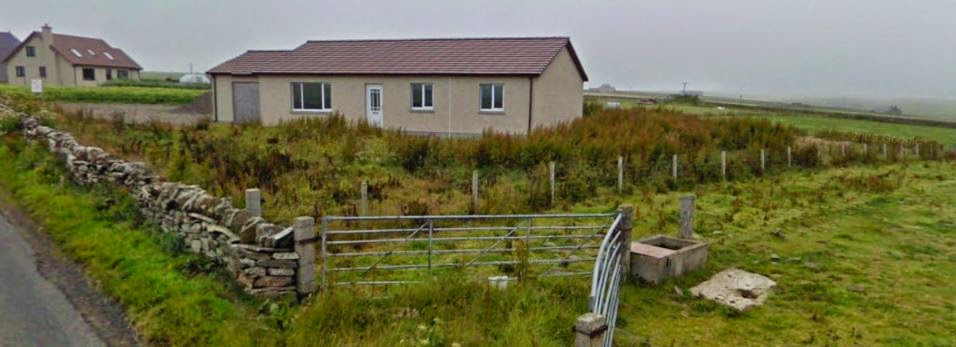It’s been 6 months since I visited my family in the North
East of England, so a trip south was long overdue. This would be my first trek
from Orkney down to the old country (on St George’s Day!) and had the added
novelty of an arrival in County Durham from the north, rather than the previously
more customary south. If that wasn’t messing with my head enough, Our Lass and
I discussed vehicle/fuel options, deciding that it would be kinder on our
pockets if I took her Nissan Micra, as opposed to my hoofing great 4x4. The
extra miles per gallon (mpg) of her wee roller skate, as well as the use of
cheaper petrol compared to diesel, would make a significant saving. This was
somewhat nullified by the fact that my mpm (miles per mug) would be an
uneconomically low value in either vehicle, requiring frequent tea stops
throughout the 500 miles from Orkney down to Middlesbrough.
This was going to be a long day in the saddle, but I was
encouraged by the prospect of perhaps seeing a few species of bird that
wouldn’t necessarily make it to Orkney. A short journey on the Orcadian side
saw me on board the Pentalina ferry for the early sailing and, after a
reasonably smooth crossing, I set off from the north of Scotland at 09.00.
In thick fog.
It was greyer than the combined greyness of a plover, a
phalarope, a heron, a wagtail and a big shrike, so I saw very little until I
reached Helmsdale and the road dropped down to sea level and below the clouds.
Soon, however, the sun came out and the stint (unintentional pun) down towards
the Black Isle produced half a dozen Common Buzzards, a possible Long-tailed
Tit and a possible Comma butterfly. Butterflies are tricky to ID when driving at
60mph. Sadly, there wasn’t a single Red
Kite to be seen, but what with the current issue of wildlife crime in the area,
this wasn’t a surprise. After Inverness, another possible butterfly (Small or
Green-veined White) was the only highlight until I arrived at Ralia Café for
lunch, to be greeted by an overture of Willow Warbler song. Ah, bliss.
South of Inverness, I assumed that I would begin to see
Magpies, but no, they were noticeably absent, along with any other Buzzard
sightings. Normally, I would expect both of these species to thrive alongside a
busy main road, with numerous road kills as a source of food. Pushing on down
through Scotland, I did spot an ‘ironically’ dead Magpie at the side of the
road, but that doesn’t really count. Even after I had passed Edinburgh, then
Berwick, and crossed the border into England, there were no raptors or scavengers
about. Somewhere in the middle of Northumberland, there was a possible Red
Kite, but an annoyingly tall hedge (and a frustratingly low Micra) prevented me
from making a definite ID.
Despite the lack of birdlife, the journey south did have a
theme. It was the colour yellow. The wildness of Scotland was typified by
Gorse, its zingy flowers even managing to look bright in the fog. And when the
sun came out, oh boy! Then the focus shifted to ground level, with masses of
Dandelions along the roadside verges. By the time I reached the lowlands of
Scotland and then the north of England, a more subdued yellow clouded my vision
from countless fields of Oil Seed, its cloying scent also drifting into the
car.
And so to Newcastle and through the Tyne Tunnel, surely
there would be a Magpie in the city whose football team plays in black and
white stripes and who are known as the Magpies?
Nope.
In a sudden switch of interest, I realised that I was
driving passed the Nissan factory in Washington, where our car had been built
about 4 years and 28000 miles previously. Immediately following this
revelation, I then saw the sign for the Stadium of Light, which is the
Sunderland football ground. Now, dear reader, the Sunderland and Newcastle
football teams are arch rivals, so as a nearby Middlesbrough supporter, I had
to chuckle when it was here, not far from Sunderland’s ground, that I saw my
first Magpies of the trip!
Then Penshaw Monument came into view, atop the hill around
which the Lambton Worm was reputed to have wound itself seven times (I think),
but before I could remember any of the numerous verses to the famous local
song, I was distracted by the sign that said ‘Welcome to County Durham, Land of
the Prince Bishops’. Yay!
Reaching the county of my birth brought a change in birding
fortune, as a Sparrowhawk flap, flap, glided across the dual carriageway in
front of me. And then in short order, the landmarks of Teesside came into view.
Chemical plants and industrial buildings, the Transporter Bridge, countless
trading estates and, in the distance, the North York Moors with the iconic silhouette
of Roseberry Topping.
I parked outside my brother’s house and gingerly unfolded
myself from the car. If I’d had a peedie dog, I would’ve said “Toto, I've a feeling we’re not in Orkney anymore.” Blossom-heavy and leafy trees decorated gardens
and hedgerows, their branches motionless in the breathless evening. The liquid
and flutey songs of numerous Blackbirds drifted through the air, a tonic for a
tired traveller. With an almost audible click, I could finally relax.
There was one surprise still to come. As my brother showed
me to my room, I was delighted to discover that the bed linen had a dragonfly
motif.







































